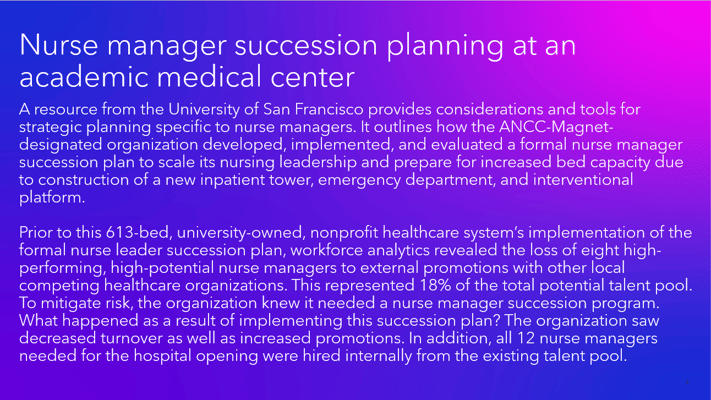Initial Steps for Effective Nurse Manager Succession Planning

Nurses at all levels are leaving their jobs in alarming numbers in the wake of the ongoing pandemic. Among nurse managers and nurse leaders specifically, 20% say they’re considering leaving or will leave their profession.
This begs the question: What would be the reaction at your healthcare organization following the resignation or retirement of a key nurse manager who supervises patient-care teams?
Would there be an immediate, detrimental effect on workforce management, quality, safety, or compliance? Or has your organization identified future leaders via a nurse manager succession plan?
Beyond Gratitude founders (The Daisy Foundation and American Organization for Nursing Leadership, sponsored by symplr and Careismatic Brands) cite nurse managers’ essential role in uniting the exceptional patient care of nurses and the mission of healthcare organizations. For example, nurse managers and nurse leaders:
- Serve in key administrative roles, overseeing daily unit-based operations to maintain safety, quality, and efficiency
- Help hire and retain vital nursing staff, a major component of which is addressing nurse fatigue and burnout
- Provide ongoing training of nurses and other staff, as well as emotional support for their teams
- Act as liaisons with other stakeholders enterprise wide
- Create and maintain departmental budgets and promote financial stewardship among their staff
As a result, nurse manager succession planning is a part of a successful workforce management strategy that prepares healthcare organizations for critical and time-sensitive transitions. When a nurse manager vacancy occurs, no one panics. The organization simply activates the plan and moves forward with as little interruption as possible.
In your health system, how easily could a successor step into the leadership role and assume nurse manager responsibilities?
What exactly is nurse manager succession planning?
Nurse manager succession planning is all about developing a talent pipeline. It includes strategies to identify potential future nurse leaders and proactively tailor work experiences to ease any necessary transitions into leadership roles. Succession planning is not synonymous with replacement hiring. The latter is focused on filling an immediate need, while the former is a proactive and deliberate process in which an organization forecasts staffing needs before a vacancy causes a leadership crisis.
Why is nurse manager succession planning so important?
Nurse manager succession planning is essential and ensures that a qualified leader is ready and able to step in and fill a leadership vacancy when it occurs. This is more important now than ever before as healthcare organizations face unprecedented nursing turnover rates.
- Sixty-two percent of U.S. hospitals report having a nursing vacancy rate higher than 7.5%.
- Thirty-five percent of hospitals have a vacancy rate higher than 10%.
- The average registered nurse (RN) turnover rate is nearly 19%.
- In addition, it takes an average of three months to recruit an experienced RN.
The American Association of Colleges of Nursing predicts a shortage of RNs that’s expected to intensify in the coming years as baby boomers age, the need for healthcare grows, and nurses face a variety of other challenges.
Without enough nurses, organizations can’t provide high-quality patient care. And without effective nurse leaders, organizations may have trouble finding and keeping enough nurses to provide that care. Organizations need nurse managers to make tough, data-driven staffing decisions and stay on top of workforce developments to ensure adequate staffing at all times. Adequate nurse staffing:
- Improves outcomes
- Reduces burnout
- Enhances job satisfaction
- Positively influences financial and operational outcomes
When healthcare organizations have a nurse manager succession plan in place, they can easily weather operational changes, because a succession plan helps prevent operational disruptions. Strategic planning also supports leadership and cultural continuity, and demonstrates a strong organizational commitment to internal human resources.
Do most hospitals have a nurse manager succession plan?
In short; no. Fewer than 7% of healthcare organizations have a formal leadership succession plan in place for nurse manager positions—despite research indicating that nurse manager succession planning provides a clear return on investment.
What should a nurse manager succession plan look like?
A nurse manager succession plan should include these basic steps at a minimum.
1. Document current nurse manager competencies and job responsibilities. Beyond basic leadership characteristics (e.g., superior clinical, verbal, and written communication skills; ability to lead and motivate others, etc.) identifying a nurse manager’s primary responsibilities is a mandatory first step in creating an effective succession plan. It ensures that organizations will seek the right person for the job and the culture.2. Assess current talent to identify potential future leaders. This action requires the use of objective, performance-based measures to help capture and identify high-performing, high-potential nurse manager talent. Organizations must assess an individual’s current performance and level of potential as well as areas of development that may be necessary to move forward.
3. Develop a nurse manager succession planning program infrastructure, including internal training and mentorship opportunities. Curriculum content for leadership development should be centered around concepts of strategic planning, business and finance management, human resources, informatics, quality improvement, team building, communication, and conflict resolution skills.

Link to resource in sidebar.
What are tips to create an effective nurse manager succession plan?
There are several universal strategies for starting an effective nurse manager succession plan. Consider these healthcare-specific tips:
- Obtain buy-in from the chief nursing officer. This individual must support and promote nurse manager succession planning so everyone is on the same page and it becomes a top-down initiative.
- Formally add nurse manager succession planning to the nursing strategic plan. It’s about having a vision for the future. By adding succession planning to the strategic plan, it’s clear that the organization is taking a proactive approach so employees aren’t caught off-guard by a sudden and potentially disorienting departure.
- Integrate nurse manager succession planning into hiring strategies. For example, once the organization identifies successors for nurse manager roles, take note of any talent gaps those successors would create if they left the organization. Then focus recruiting efforts on individuals who possess those talents.
Equipping nurses with the leadership competencies to transition into nurse manager roles is essential as the industry faces lingering challenges from the pandemic, as well as a host of other staffing and workforce challenges. When there are nurse manager vacancies, a formal succession plan ensures that there is an internal talent pool of next-in-line leaders who are ready to step into new roles immediately. This not only benefits patient care, but it can also reduce recruitment and replacement costs.
The most successful healthcare organizations will be those that integrate nurse manager succession planning into their strategic plan and provide a proactive method for identifying and developing future potential leaders. The time to develop talent is now. Don’t wait until a nurse manager leaves the organization to fill an open position. Your organization simply can’t afford it.
 Read additional posts in our series celebrating National Nurses Week:
Read additional posts in our series celebrating National Nurses Week: